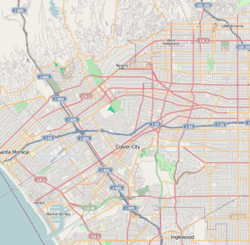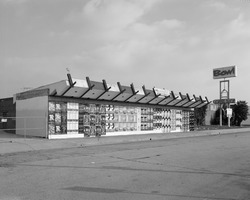Crenshaw, Los Angeles facts for kids
Quick facts for kids
Crenshaw
|
|
|---|---|
| Nickname(s):
The 'Shaw
|
|
| Country | United States |
| State | California |
| County | Los Angeles |
| City | Los Angeles |
| Time zone | Pacific |
| ZIP Code |
90008
|
| Area Code | 323 |
Crenshaw, also known as the Crenshaw District, is a lively neighborhood in South Los Angeles, California. It's famous for its rich history and diverse community.
After World War II, many Japanese American families made Crenshaw their home. Later, in the mid-1960s, African Americans began moving to the area. By the early 1970s, they became the main population group.
Today, the Crenshaw Boulevard area is still a very important place. It is known as "the heart of African American commerce in Los Angeles." Many different cultures have shaped this area over the years.
Contents
Discovering Crenshaw's Past
Crenshaw has faced some tough times. It was damaged during the 1992 Los Angeles riots and the 1994 Northridge earthquake. But the community worked hard to rebuild. By the late 2000s, Crenshaw began to recover and grow stronger. This was thanks to new development and changes in the area.
Exploring Crenshaw's Location
Crenshaw is a neighborhood in Los Angeles. It is centered around Crenshaw Boulevard and Buckingham Road. To the south, you'll find Baldwin Hills. Baldwin Village is to the west. Leimert Park is to the east, and Crenshaw Manor is to the north.
Some maps show Crenshaw covering a larger area. This includes parts of Baldwin Hill Estates, Baldwin Hill, and Baldwin Village. It also includes southern parts of West Adams and Jefferson Park. The neighborhood's borders generally follow major streets. These include Crenshaw Boulevard, Stocker Street, and South La Brea Avenue.
Understanding Crenshaw's People
Crenshaw has always been a place where different cultures live together. After World War II, a large Japanese-American community grew here. They even had their own school, Dai-Ichi Gakuen. Japanese Americans and African Americans often formed close bonds. This was partly because they both faced similar challenges.
At its busiest, around 1970, about 8,000 Japanese Americans lived in Crenshaw. Dai-Ichi Gakuen had 700 students. This made it one of the biggest Japanese-American communities in California.
In the 1970s, the Japanese American community started to shrink. Businesses also began to leave. Some people thought this was a delayed effect of the 1965 Watts riots. Others said it was because younger generations moved away after college. By 1993, most Japanese Americans in Crenshaw were older residents. However, in the 1990s, some younger Japanese Americans started moving back.
Today, Crenshaw is still changing. Many middle and lower-class Black and Latino families are moving to other parts of Southern California. This is part of a process called gentrification. This process continues as the Crenshaw mall is being updated. It will soon have new apartments, shops, and restaurants.
Learning in Crenshaw
Public schools in Crenshaw are managed by the Los Angeles Unified School District (LAUSD). Students have many choices for their education.
Local Schools
- Crenshaw High School is a public high school. It is located south of Martin Luther King Jr. Boulevard. It is also east of Crenshaw Boulevard.
- Susan Miller Dorsey High School is another important school in the area.
There are also several charter schools in Crenshaw. These schools offer different learning styles.
- KIPP Academy of Opportunity, part of the KIPP network.
- Celerity Nascent Charter School
- The New Design Charter School, built in 2004.
- View Park Preparatory High School
- View Park Preparatory Middle School.
Life in Crenshaw
Crenshaw is mostly a place where people live. You'll find many single-story houses and bungalows. There are also low-rise condominiums and apartment buildings.
The neighborhood also has business areas. There is an industrial corridor along Jefferson Boulevard. Other commercial districts are spread throughout Crenshaw.
After old laws that limited where people could live were changed, Crenshaw became open to all races. This led to the large Japanese American community. Later, in the mid-1960s, African Americans began moving in. By the early 1970s, they became the majority.
In the 1970s, Crenshaw, Leimert Park, and nearby areas formed a large African-American community. It was one of the biggest in the western United States.
Getting Around Crenshaw
The K line, also called the Crenshaw/LAX Line, helps people travel. It's a train line that runs north and south. It goes along Crenshaw Boulevard. The line connects the Expo/Crenshaw station to the Aviation/96 Street station.
Famous Places in Crenshaw
- The Baldwin Hills Crenshaw Plaza is a well-known shopping mall. It used to have big stores like Wal-Mart, Sears, and Macy's.
- Marlton Square was another shopping center. It was an older center that was planned for new development.
- The Crenshaw Square Shopping Centre is a local landmark. Its famous sign was updated in 2007. The outdoor shopping center was renovated in 2016.
- The West Angeles Church of God in Christ is a large Pentecostal church. It is near Crenshaw and Exposition boulevards.
Historic Landmarks
- The Holiday Bowl was once a popular bowling alley and café. It was known for bringing different cultures together in the 1960s and 1970s. It even had a sushi bar! The building has a cool, modern style called Googie architecture. This style has been restored by its new tenants, Starbucks and Walgreens. It is now part of a new outdoor shopping center that opened in 2006. The Holiday Bowl is recognized as City of Los Angeles Historic Cultural Monument #688.
Crenshaw in Media
Crenshaw has been featured in books, movies, and TV shows.
Books
- The novel Southland, by Nina Revoyr, tells a story set in the Crenshaw neighborhood.
Movies
- The movie Boyz n the Hood takes place in the area.
Television
- The TV series All American features Crenshaw. The main character, Spencer James, lives there.
Fun Events in Crenshaw
Crenshaw hosts exciting events throughout the year.
- The annual Kingdom Day Parade celebrates Martin Luther King Jr.. This parade is usually shown on TV in Los Angeles. It travels along Martin Luther King Jr. Boulevard to Crenshaw Boulevard.
- The Taste of Soul Festival happens every October. It started in 2005 and is a big community event.
Famous People from Crenshaw
Many talented people have lived in Crenshaw.
- Tom Bradley, a former mayor of Los Angeles
- Darwin Cook, NBA basketball player
- Baron Davis, NBA basketball player
- Eric Davis, MLB baseball player
- Richard Elfman and Danny Elfman, musicians
- Tremaine Fowlkes, NBA basketball player
- David Fulcher, NFL football player
- Tiffany Haddish, comedian and actress
- James Hahn, a former mayor of Los Angeles
- Kenneth Hahn (1920–1997), a Los Angeles County leader
- Nipsey Hussle (1985–2019), rapper and community activist
- Ice Cube, rapper
- Ice-T, musician and actor
- DeSean Jackson, NFL football player
- Dom Kennedy, rapper
- Kurupt, rapper
- Arthur Lee, singer
- Lords of Lyrics, rap group
- Spencer Paysinger, NFL football player
- Peter Ramsey, film director
- Skee-Lo, rapper
- Darryl Strawberry, MLB baseball player
- Syd, singer and producer
- De'Anthony Thomas, NFL football player
- Pam Ward, novelist







